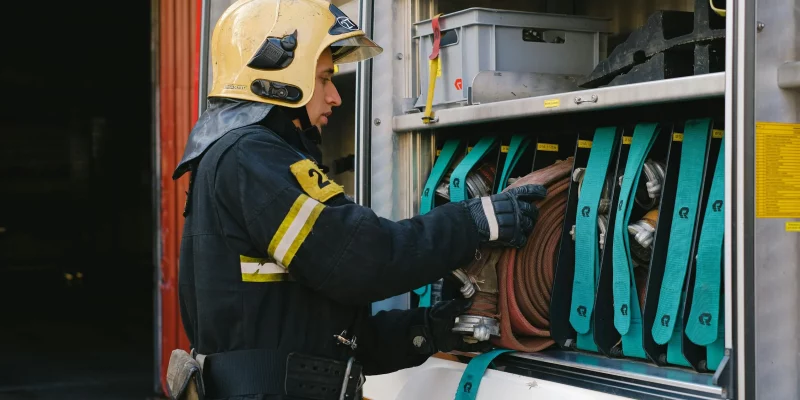Firefighters are revered as heroes, valiantly risking their lives to save others and protect property from the ravages of fire. However, beyond the visible dangers of flames and smoke lies a hidden menace threatening their health and well-being. That’s why facilities such as SCBA respirators should be provided.
From toxic smoke inhalation to long-term physical and mental health impacts, firefighters face a myriad of health hazards. In this article, we delve into the lesser-known health dangers firefighters face, shedding light on the challenges they confront beyond the flames.
Understanding the Risks
Firefighting is inherently hazardous, exposing individuals to a variety of toxic substances and dangerous conditions. One of the primary health risks faced by firefighters is smoke inhalation. The smoke generated by fires contains a complex mixture of gaseous and particulate matter, including carbon monoxide, hydrogen cyanide, and various carcinogens.
Inhaling these toxic substances can lead to immediate respiratory distress and long-term health complications. Moreover, firefighters risk thermal injuries from exposure to extreme heat and flames. Burns, heat stress, and heat-related illnesses are common occurrences in firefighting operations, posing significant risks to physical health and operational effectiveness.
These risks can be fatal, too. In fact, the death rate due to occupational hazards is the highest among firefighters, as stated in an NCBI article. A statistical study by the U.S. Fire Administration shows 141 firefighters died from injuries received in the line of duty in 2021.
Hidden Health Hazards
Firefighters face many health hazards in their line of duty, many of which are not immediately obvious. Some of these hidden health hazards include:
Respiratory Conditions
One of the most common respiratory issues is smoke inhalation. When firefighters are exposed to smoke from burning buildings, they inhale a complex mixture of toxic gases, particles, and chemicals. This can lead to acute respiratory distress syndrome (ARDS) or exacerbate pre-existing conditions such as asthma or chronic obstructive pulmonary disease (COPD).
Additionally, firefighters risk developing bronchitis and pneumonia from inhaling smoke and other particulate matter. These conditions can cause inflammation of the airways and lungs, leading to coughing, wheezing, chest pain, and difficulty breathing.
Over time, repeated exposure to smoke and other respiratory hazards may contribute to the development of long-term respiratory conditions. For instance, firefighters can be more vulnerable to bronchial hyperreactivity and fibrosis. According to an NCBI study, lung diseases are becoming an increasing occupational hazard for firefighters.
Cancer
Exposure to hazardous substances released during fires, such as carcinogens, presents a significant risk to firefighters’ health. These carcinogens can come from burning materials like plastics, synthetic materials, and chemicals commonly found in buildings and vehicles. The combustion process can release toxic compounds that firefighters may inhale or absorb through their skin.
Another source of carcinogens is the Aqueous Film Forming Foam (AFFF). According to TorHoerman Law, AFFF contains PFAS (per- and polyfluoroalkyl substances). The PFAS chemicals present in AFFF are Perfluorooctanoic Acid (PFOA) and Perfluorooctane Sulfonate (PFOS). As the American Cancer Society states, both these chemicals are known to increase the risk of cancers.
PFAS are also known as forever chemicals, as they can bioaccumulate. Since firefighters are exposed to AFFF regularly, they are at a higher risk of developing different types of cancers. In fact, many professionals and their loved ones have filed the AFFF firefighter foam lawsuit against the manufacturers.
Physical Injuries
One of the most common injuries is musculoskeletal strains and sprains. They often result from lifting heavy equipment, carrying victims, or navigating uneven terrain in challenging environments. The repetitive physical demands of firefighting, such as climbing ladders and dragging hoses, significantly strain muscles and joints, leading to chronic injuries.
Burn injuries are another prevalent risk for firefighters due to exposure to flames, extreme heat, and hazardous materials. While protective gear can mitigate some of these risks, intense heat, and flames can still cause burns ranging from minor to severe.
Traumatic injuries, including fractures, lacerations, and contusions, are common occurrences during firefighting operations. These injuries can result from structural collapses, falls, or encounters with sharp objects and debris in hazardous environments.
Mental Health Problems
Firefighters are exposed to numerous mental health challenges due to the nature of their profession. One significant issue they face is post-traumatic stress disorder (PTSD), resulting from exposure to events like witnessing fatalities or facing life-threatening situations.
These experiences can lead to intrusive memories, nightmares, hypervigilance, and avoidance behaviors, significantly impacting their mental well-being. A Frontiers Journal study found a PTSD prevalence of 8.6% among firefighters. Moreover, a 14.4% prevalence was found for psychopathology conditions.
Another common mental health problem among firefighters is depression. The constant exposure to distressing incidents can contribute to feelings of sadness, hopelessness, and low self-esteem. Depression not only affects their personal lives but also impairs their ability to carry out their duties efficiently.
Substance abuse is also prevalent among firefighters as a coping mechanism for dealing with stress and trauma. The high-stress environment and easy access to alcohol or prescription drugs can lead to substance dependency.
Protective Measures
Due to firefighters ‘ diverse health risks, efforts have been made to implement preventive measures and improve safety protocols. Personal protective equipment (PPE), including turnout gear, self-contained breathing apparatus (SCBA), and helmets, serves as a crucial line of defense.
Properly fitted and maintained PPE can significantly reduce exposure to toxic substances and minimize the risk of injury. A Stellar Market Research study shows that helmets were the most used PPE. In 2023, helmets dominated the market with a 28% market share.
In addition to PPE, comprehensive training programs and ongoing education are essential. They can equip firefighters with the knowledge and skills to mitigate risks and respond effectively to emergencies. Training should encompass firefighting techniques and safety protocols for hazardous materials incidents, medical emergencies, and behavioral health support.
Frequently Asked Questions
What Measures Can Firefighters Take to Minimize These Health Risks?
Firefighters can take several measures to protect themselves, including using proper PPE. They can also implement thorough decontamination procedures after exposure to contaminants, practice good hygiene, and maintain a healthy lifestyle.
What Steps Can Be Taken to Raise Awareness About Firefighters’ Health Risks?
It is crucial to raise awareness about the hidden health dangers faced by firefighters. This can be achieved through educational initiatives, training programs, and advocacy for better safety standards and regulations.
How Can Communities Support Firefighters in Addressing These Health Challenges?
Communities can support firefighters by advocating for better resources, funding, and legislation to address their health challenges. This may involve contacting elected officials, supporting organizations dedicated to firefighter health and safety, and volunteering for initiatives to raise awareness.
In conclusion, firefighters confront many hidden health dangers that pose significant risks to their well-being. From toxic smoke inhalation to long-term health impacts, the occupational hazards of firefighting are diverse and insidious.
By raising awareness of these challenges, we can better support the health and safety of firefighters. We must honor their service in times of crisis and safeguard their health and well-being beyond the flames.




















